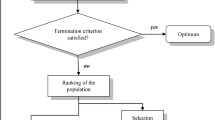Abstract
A steelworks model is selected as representative of the stochastic and unpredictable behaviour of a complex discrete event simulation model. The steel-works has a number of different entity or object types. Using the number of each entity type as parameters, it is possible to find better and worse combinations of parameters for various management objectives. A simple real-coded genetic algorithm is presented that optimises the parameters, demonstrating the versatility that genetic algorithms offer in solving hard inverse problems.
Similar content being viewed by others
References
Andradottir S. Discrete Optimization in simulation: A method and applications. In: Swain JJ, Gainsman D (eds). Proceedings of the 1992 Winter Simulation Conference. Society for Computer Simulation, San Diego, CA, 1992; 483–486
Evans GW, Stuckman B, Mollaghasemi M. Multicriteria optimization of simulation models. In: Nelson BL, Kelton WD, Clark GM (eds). Proceedings of the 1991 Winter Simulation Conference. Society for Computer Simulation, San Diego, CA, 1991; 894–899
Stuckman B, Evans G, Mollaghasemi M. Comparison of global search methods for design optimization using simulation. In: Nelson BL, Kelton WD, Clark GM (eds). Proceedings of the 1991 Winter Simulation Conference. Society for Computer Simulation, San Diego, CA, 1991; 937–943
Tomkins G, Azadivar F. Genetic algorithms in optimizing simulated systems. In: Alexopoulos C, Kang K, Lilegdon WR, Goldsman D (eds). Proceedings of the 1995 Winter Simulation Conference. Society for Computer Simulation, San Diego, CA, 1995; 757–762
Holder RD, Gittins RP. The effects of warship and replenishment attrition on war arsenal requirements. Journal of the Operational Research Society 1989; 40: 167–175
Kirkpatrick S, Gelatt CD Jr., Vecchi MP. Optimisation by simulated annealing. Science 1983; 220: 671–680
Goldberg DE. Genetic Algorithms in Search, Optimisation and Machine Learning. Addison-Wesley, Reading, 1989
Holland JH. Adaptation in Natural and Artificial Systems. University of Michigan Press, Ann Arbor, MI, 1975
Paul RJ, Balmer DW. Simulation Modelling. Chartwell-Bratt, Stockholm, 1993
VS6 and VS7 User Manuals. Syspack Ltd., London, 1992
Reeves CR. Genetic algorithms for the operations researcher. INFORMS Journal on Computing 1997; 9(3): 231–250
Author information
Authors and Affiliations
Rights and permissions
About this article
Cite this article
Paul, R.J., Chanev, T.S. Optimising a complex discrete event simulation model using a genetic algorithm. Neural Comput & Applic 6, 229–237 (1997). https://doi.org/10.1007/BF01501509
Issue Date:
DOI: https://doi.org/10.1007/BF01501509




